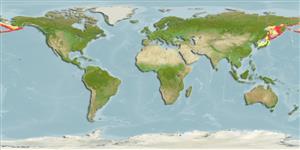Teleostei (teleosts) >
Pleuronectiformes (Flatfishes) >
Pleuronectidae (Righteye flounders) > Atheresthinae
Etymology: Atheresthes: Greek, atheres = spike + The name of Astyanax, Hector´s son in the Greek mithology (Ref. 45335).
More on authors: Jordan & Starks.
Environment: milieu / climate zone / depth range / distribution range
Ecology
Marine; demersal; depth range 20 - 1200 m (Ref. 50550). Temperate; 66°N - 35°N, 130°E - 153°W (Ref. 6793)
North Pacific: Sea of Japan and the Sea of Okhotsk north to the Anadyr Gulf, through the eastern Bering Sea to the Aleutian Islands and the Shelikof Strait in Alaska.
Size / Weight / Age
Maturity: Lm ? range ? - ? cm
Max length : 100.0 cm SL male/unsexed; (Ref. 559); common length : 54.0 cm TL male/unsexed; (Ref. 56527); max. published weight: 8.5 kg (Ref. 56527); max. reported age: 33 years (Ref. 55701)
Short description
Identification keys | Morphology | Morphometrics
Life cycle and mating behavior
Maturities | Reproduction | Spawnings | Egg(s) | Fecundities | Larvae
Vinnikov, K.A., R.C. Thomson and T.A. Munroe, 2018. Revised classification of the righteye flounders (Teleostei: Pleuronectidae) based on multilocus phylogeny with complete taxon sampling. Molecular phylogenetics and evolution, 125:147-162. (Ref. 122998)
IUCN Red List Status (Ref. 130435)
Threat to humans
Harmless
Human uses
Fisheries: commercial
Tools
Special reports
Download XML
Internet sources
Estimates based on models
Preferred temperature (Ref.
123201): 0.7 - 5.4, mean 1.7 °C (based on 287 cells).
Phylogenetic diversity index (Ref.
82804): PD
50 = 0.7500 [Uniqueness, from 0.5 = low to 2.0 = high].
Bayesian length-weight: a=0.00759 (0.00559 - 0.01029), b=3.03 (2.94 - 3.12), in cm total length, based on LWR estimates for this species (Ref.
93245).
Trophic level (Ref.
69278): 4.3 ±0.2 se; based on diet studies.
Generation time: 13.7 ( na - na) years. Estimated as median ln(3)/K based on 2
growth studies.
Resilience (Ref.
120179): Low, minimum population doubling time 4.5 - 14 years (Assuming tm>4; tmax=33).
Prior r = 0.18, 95% CL = 0.12 - 0.27, Based on 2 full stock assessments.
Fishing Vulnerability (Ref.
59153): High vulnerability (64 of 100).
Climate Vulnerability (Ref.
125649): Moderate vulnerability (44 of 100).
Nutrients (Ref.
124155): Calcium = 20.2 [8.0, 35.3] mg/100g; Iron = 0.244 [0.123, 0.466] mg/100g; Protein = 17.2 [15.9, 18.6] %; Omega3 = 0.375 [0.180, 0.771] g/100g; Selenium = 26.7 [13.1, 59.3] μg/100g; VitaminA = 10.3 [2.3, 45.7] μg/100g; Zinc = 0.281 [0.186, 0.427] mg/100g (wet weight);
